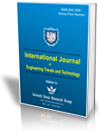Deep Learning Based Cardiovascular Disease Detection Using ECG Images
Deep Learning Based Cardiovascular Disease Detection Using ECG Images |
||
 |
 |
|
| © 2025 by IJETT Journal | ||
| Volume-73 Issue-10 |
||
| Year of Publication : 2025 | ||
| Author : S.G. Bagul, S.B. Bagal, S.V. Chaudhari, B.S. Agarkar | ||
| DOI : 10.14445/22315381/IJETT-V73I10P124 | ||
How to Cite?
S.G. Bagul, S.B. Bagal, S.V. Chaudhari, B.S. Agarkar,"Deep Learning Based Cardiovascular Disease Detection Using ECG Images", International Journal of Engineering Trends and Technology, vol. 73, no. 10, pp.312-326, 2025. Crossref, https://doi.org/10.14445/22315381/IJETT-V73I10P124
Abstract
Cardiovascular disease is the most significant cause of mortality throughout the globe, as stated by the World Health Organization (WHO). Researchers are interested in detecting Cardiovascular Disease (CVD) using electrocardiography (ECG) images due to their simplicity of use, explainability, visualization, and representational potential. Based on the Deep Learning-Based Two-Way Feature Depiction (DLTWFD), which is derived from a 2-D Deep Convolutional Neural Network (2D DCNN) and a 1-D Deep Convolutional Neural Network (1D-DCNN), this research presents a CVD detection method based on the DLTWFD. For the purpose of providing connection and correlation in the initial ECG pattern, the 2-D DCNN takes the raw ECG pictures as input. To give the correlation between various texture and shape properties of the ECG pictures and to describe the local and global changes in the ECG pattern that are caused by CVD, the 1-D DCNN accepts the Modified Local Ternary Pattern (MLTP) and the Histogram of Oriented Gradient (HOG) features. By combining the deep qualities from raw ECG pictures, texture, and form features of the ECG, the DLTWFD presented improves the uniqueness of the features. The proposed DLTWFD achieves an overall accuracy of 98.20%, a recall of 98.20%, a precision of 98.10%, and an F1-score of 98.05%, surpassing the current state of the art.
Keywords
Biomedical Image Processing, Cardiovascular Disease Detection, Deep Convolution Neural Network, Histogram of Oriented Gradients, Local Ternary pattern, Texture Descriptor, Machine Learning.
References
[1] Gaziano T et al., Cardiovascular Diseases, Disease Control Priorities in Developing Countries, 2nd ed., 2006.
[Google Scholar] [Publisher Link]
[2] Connie W. Tsao et al., “Heart Disease and Stroke Statistics-2022 Update: A Report from the American Heart Association,” Circulation, vol. 145, no. 8, pp. e153-e639, 2022.
[CrossRef] [Google Scholar] [Publisher Link]
[3] Connie W. Tsao et al., “Heart Disease and Stroke Statistics-2023 Update: A Report from the American Heart Association,” Circulation, vol. 147, no. 8, pp. e93-e621, 2023.
[CrossRef] [Google Scholar] [Publisher Link]
[4] Md Manjurul Ahsan, and Zahed Siddique, “Machine Learning-Based Heart Disease Diagnosis: A Systematic Literature Review,” Artificial Intelligence in Medicine, vol. 128, pp. 1-23, 2022.
[CrossRef] [Google Scholar] [Publisher Link]
[5] Jahmunah, Vicnesh et al., “Computer-Aided Diagnosis of Congestive Heart Failure Using ECG Signals-A Review,” Physica Medica, vol. 62, pp. 95-104, 2019.
[CrossRef] [Google Scholar] [Publisher Link]
[6] Ali Haider Khan, Muzammil Hussain, and Muhammad Kamran Malik, “Cardiac Disorder Classification by Electrocardiogram Sensing Using Deep Neural Network,” Complexity, vol. 2021, no. 1, pp. 1-8, 2021.
[CrossRef] [Google Scholar] [Publisher Link]
[7] Zachi I. Attia et al., “Application of Artificial Intelligence to the Electrocardiogram,” European Heart Journal, vol. 42, no. 46, pp. 4717-4730, 2021.
[CrossRef] [Google Scholar] [Publisher Link]
[8] Yehualashet Megersa Ayano et al., “Interpretable Machine Learning Techniques in ECG-Based Heart Disease Classification: A Systematic Review,” Diagnostics, vol. 13, no. 1, pp. 1-37, 2022.
[CrossRef] [Google Scholar] [Publisher Link]
[9] Santanu Kumar Sahoo, et al., “Machine Learning Approach to Detect Cardiac Arrhythmias in ECG Signals: A Survey,” IRBM, vol. 41, no. 4, pp. 185-194, 2020.
[CrossRef] [Google Scholar] [Publisher Link]
[10] Atiaf Ayal Rawi, Murtada Kalafalla Albashir, and Awadallah Mohammed Ahmed. “Classification and Detection of ECG Arrhythmia and Myocardial Infarction Using Deep Learning: A Review,” Webology, vol. 19, no. 1, pp. 1151-1170, 2022.
[CrossRef] [Google Scholar] [Publisher Link]
[11] Hongzu Li, and Pierre Boulanger, “A Survey of Heart Anomaly Detection Using Ambulatory Electrocardiogram (ECG),” Sensors, vol. 20, no. 5, pp. 1-33, 2020.
[CrossRef] [Google Scholar] [Publisher Link]
[12] Carlos Martin-Isla et al., “Image-Based Cardiac Diagnosis with Machine Learning: A Review,” Frontiers in Cardiovascular Medicine, vol. 7, pp. 1-19, 2020.
[CrossRef] [Google Scholar] [Publisher Link]
[13] Lakshmi Prasad Koyi, Tejaswi Borra, and G. Lakshmi Vara Prasad, “A Research Survey on State of the art Heart Disease Prediction Systems,” 2021 International Conference on Artificial Intelligence and Smart Systems (ICAIS), Coimbatore, India, pp. 799-806, 2021.
[CrossRef] [Google Scholar] [Publisher Link]
[14] Xinwen Liu et al., “Deep Learning in ECG Diagnosis: A Review,” Knowledge-Based Systems, vol. 227, 2021.
[CrossRef] [Google Scholar] [Publisher Link]
[15] Shenda Hong et al., “Opportunities and Challenges of Deep Learning Methods for Electrocardiogram Data: A Systematic Review,” Computers in Biology and Medicine, vol. 122, pp. 1-16, 2022.
[CrossRef] [Google Scholar] [Publisher Link]
[16] Steve S. Ryan, Understanding the EKG Signal, Atrial Fibrillation: Resources for Patients, 2020. [Online] Available: https://a-fib.com/treatments-for-atrial-fibrillation/diagnostic-tests-2/the-ekg-signal
[17] Yasar Sattar, and Lovely Chhabra, Electrocardiogram, StatPearls Publishing, 2023.
[Google Scholar] [Publisher Link]
[18] Ana Mincholé, and Blanca Rodriguez, “Artificial Intelligence for the Electrocardiogram,” Nature Medicine, vol. 25, no. 1, pp. 22-23, 2019.
[CrossRef] [Google Scholar] [Publisher Link]
[19] Donna Giri et al., “Automated Diagnosis of Coronary Artery Disease Affected Patients using LDA, PCA, ICA, and Discrete Wavelet Transform,” Knowledge-Based Systems, vol. 37, pp. 274-282, 2013.
[CrossRef] [Google Scholar] [Publisher Link]
[20] Shivnarayan Patidar, Ram Bilas Pachori, and U. Rajendra Acharya, “Automated Diagnosis of Coronary Artery Disease Using Tunable-Q Wavelet Transform Applied on Heart Rate Signals,” Knowledge-Based Systems, vol. 82, pp. 1-10, 2015.
[CrossRef] [Google Scholar] [Publisher Link]
[21] Mohit Kumar, Ram Bilas Pachori, and U. Rajendra Acharya, “An Efficient Automated Technique for CAD Diagnosis Using Flexible Analytic Wavelet Transform and Entropy Features Extracted from HRV Signals,” Expert Systems with Applications, vol. 63, pp. 165-172, 2016.
[CrossRef] [Google Scholar] [Publisher Link]
[22] Surabhi Sood et al., “Application of Empirical Mode Decomposition-Based Features for Analysis of Normal and Cad Heart Rate Signals,” Journal of Mechanics in Medicine and Biology, vol. 16, no. 1, pp. 1-20, 2016.
[CrossRef] [Google Scholar] [Publisher Link]
[23] Roohallah Alizadehsani et al., “Coronary Artery Disease Detection Using Computational Intelligence Methods,” Knowledge-Based Systems, vol. 109, pp. 187-197, 2016.
[CrossRef] [Google Scholar] [Publisher Link]
[24] Zeinab Arabasadi et al., “Computer-Aided Decision Making for Heart Disease Detection Using a Hybrid Neural Network-Genetic Algorithm,” Computer Methods and Programs in Biomedicine, vol. 141, pp. 19-26, 2017.
[CrossRef] [Google Scholar] [Publisher Link]
[25] Tahmida Tabassum, and Monira Islam, “An Approach of Cardiac Disease Prediction by Analyzing ECG Signal,” 2016 3rd International Conference on Electrical Engineering and Information Communication Technology (ICEEICT), Dhaka, Bangladesh, pp. 1-5, 2016.
[CrossRef] [Google Scholar] [Publisher Link]
[26] Aditi Gavhane et al., “Prediction of Heart Disease Using Machine Learning,” 2018 Second International Conference on Electronics, Communication and Aerospace Technology (ICECA), Coimbatore, India, pp. 1275-1278, 2018.
[CrossRef] [Google Scholar] [Publisher Link]
[27] Senthilkumar Mohan, Chandrasegar Thirumalai, and Gautam Srivastava, “Effective Heart Disease Prediction Using Hybrid Machine Learning Techniques,” IEEE Access, vol. 7, pp. 81542-81554, 2019.
[CrossRef] [Google Scholar] [Publisher Link]
[28] Vineet Sharma, Akhtar Rasool, and Gaurav Hajela, “Prediction of Heart Disease Using DNN,” 2020 Second International Conference on Inventive Research in Computing Applications (ICIRCA), Coimbatore, India, pp. 554-562, 2020.
[CrossRef] [Google Scholar] [Publisher Link]
[29] Jian Ping Li et al., “Heart Disease Identification Method Using Machine Learning Classification in E-Healthcare,” IEEE Access, vol. 8, pp. 107562-107582, 2020.
[CrossRef] [Google Scholar] [Publisher Link]
[30] K. Prajwal et al., “Cardiovascular Disease Prediction Using Machine Learning,” 2022 International Conference on Innovative Trends in Information Technology (ICITIIT), Kottayam, India, pp. 1-6, 2022.
[CrossRef] [Google Scholar] [Publisher Link]
[31] Yan Fang et al., “Electrocardiogram Signal Classification in the Diagnosis of Heart Disease Based on RBF Neural Network,” Computational and Mathematical Methods in Medicine, vol. 2022, no. 1, pp. 1-9, 2022.
[CrossRef] [Google Scholar] [Publisher Link]
[32] Niloy Biswas et al., “Machine Learning-Based Model to Predict Heart Disease in Early Stage Employing Different Feature Selection Techniques,” BioMed Research International, vol. 2023, no. 1, pp. 1-15, 2023.
[CrossRef] [Google Scholar] [Publisher Link]
[33] Ali Haider Khan, and Muzammil Hussain, “ECG Images Dataset of Cardiac Patients,” Mendeley Data, vol. 2, 2021.
[CrossRef] [Publisher Link]
[34] Kishor B. Bhangale, and K. Mohanaprasad, “Content Based Image Retrieval Using Collaborative Color, Texture and Shape Features,” International Journal of Innovative Technology and Exploring Engineering (IJITEE), vol. 9, no. 3, pp. 1466-1469, 2020.
[CrossRef] [Google Scholar] [Publisher Link]
[35] Y.G. Naresh, and H.S. Nagendraswamy, “Classification of Medicinal Plants: An Approach Using Modified LBP with Symbolic Representation,” Neurocomputing, vol. 173, pp. 1789-1797, 2016.
[CrossRef] [Google Scholar] [Publisher Link]
[36] Li Liu et al., “Extended Local Binary Patterns for Texture Classification,” Image and Vision Computing, vol. 30, no. 2, pp. 86-99, 2012.
[CrossRef] [Google Scholar] [Publisher Link]
[37] Xiaoyang Tan, and Bill Triggs, “Enhanced Local Texture Feature Sets for Face Recognition Under Difficult Lighting Conditions,” IEEE Transactions on Image Processing, vol. 19, no. 6, pp. 1635-1650, 2010.
[CrossRef] [Google Scholar] [Publisher Link]
[38] Lotfi Mhamdi et al., “Artificial Intelligence for Cardiac Disease Diagnosis and Prediction Using ECG Images on Embedded Systems,” Biomedicines, vol. 10, no. 8, pp. 1-16, 2022.
[CrossRef] [Google Scholar] [Publisher Link]
[39] Kishor Bhangale et al., “Machine Learning Based Heart Disease Prediction Using ECG Image,” 2024 5th International Conference for Emerging Technology (INCET), Belgaum, India, pp. 1-9, 2024.
[CrossRef] [Google Scholar] [Publisher Link]

